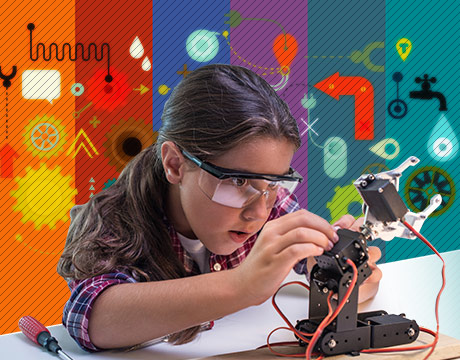How to Homeschool Engineering Students, Part 2
How to Homeschool Engineering Students, Part 2


Part 1 of “STEM Education Hits Home” showcased the trends behind homeschooling and the challenge of incorporating STEM subject into the curriculum. In this section, we look at the different resources parents and other educators can use to teach engineering at home.
Curriculum Resources
EEME, an acronym for electrical engineer/mechanical engineer, is a web-based engineering curriculum that helps parents teach their 7-12 year-olds the basics of electronics and robotics through hands-on building projects. The EEME program works on a subscription basis. New subscribers receive reusable base components (a baseplate, breadboard, and battery pack) to begin with, and thereafter they get a bag of components for a new project. Online video building instructions and other curriculum materials are designed for use by parents or instructors without an engineering background. In addition, one-off robotics kits for older kids are available without a subscription. Non-subscribers can access lesson guides for free by creating an online EEME account.
TeachEngineering offers a free online curriculum library to help educators design an engineering-focused curriculum aligned with state or national STEM educational standards. The National Science Foundation-funded initiative was developed by a consortium of U.S. engineering colleges led by the University of Colorado. The curriculum is populated with individual activities, longer lessons and full units focused on skills like data analysis, measurement, reasoning, and mathematics. Lessons touch on a broad range of STEM subjects such as the life sciences, chemistry and physics. Online “living labs” allow students to access government research data and modeling software for hands-on projects in seismology and energy efficiency.
For younger children, STEM educators typically incorporate science and engineering concepts into play exercises. A number of homeschool websites and blogs like this one offer guidance and free materials for preparing a do-it-yourself homeschool STEM curricula for preschoolers and early elementary school students.
More for You: Read how Experiential Learning and Cooperative Education Pay Off
In response to the growing shortage of supply chain professionals as baby boomers leave the workforce, APICS has developed the SupplyChain STEM outreach program. Designed to introduce K-12 students to the importance of supply chain management, the program offers a wide range of hands-on activities that teach the basics of STEM and explain the role of scientists and engineers in each step of the supply chain. The STEM curriculum can be taught by volunteers either in traditional schools or in non-traditional learning environments.
Inspiration and Ideas
The web is full of free food for thought for parents considering the homeschool switch for their STEM-savvy children. What better place to dive in than in this round-up of well-known engineers and scientists who obtained at least part of their education at home. Five useful tips for exposing children to engineering learning at an early age are offered at homeschooltracker.com. At stemmom.org, discussion of all things STEM education is accompanied by a clearinghouse of links to free online lessons, activities and labs ideal for homeschool use. Similar information appears in the wide range of STEM activity books available for kids of various ages.
What’s the homeschooling experience like from the student’s point of view? The “Homeschooled Engineer” blog, although a few years old, offers some useful insights that would-be home educators should bear in mind when contemplating the homeschool decision. Similarly, the website homeschoolsuccess.org offers these practical tips for home learners hoping to transition into college-level engineering.
If the past is any indication, great minds will continue to push the boundaries of science and engineering regardless of where they were educated. By stimulating a child’s natural inclination to explore, analyze and create at his or her own pace, resources like these can only help history repeat itself.
Michael MacRae is an independent writer.


.png?width=854&height=480&ext=.png)


